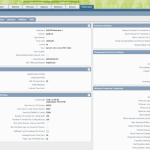Unveiling The Majestic Panorama Of The Old Testament: Dive Into Ancient Wisdom And Ignite Your Faith!
Panorama of the Old Testament
Introduction
Hello, Happy People! In this article, we will explore the fascinating panorama of the Old Testament. The Old Testament, also known as the Hebrew Bible, is a sacred text in Judaism and Christianity. It encompasses a rich collection of religious writings, historical accounts, laws, and prophecies. Understanding the panorama of the Old Testament is crucial for gaining insights into the origins of these religions and the development of religious thought throughout history. So, let’s embark on this journey and uncover the wonders of the Old Testament!
1 Picture Gallery: Unveiling The Majestic Panorama Of The Old Testament: Dive Into Ancient Wisdom And Ignite Your Faith!
What is the Old Testament?
📚 The Old Testament refers to the first section of the Christian Bible and the entire Hebrew Bible. It contains various books, including the books of Genesis, Exodus, Leviticus, Numbers, and Deuteronomy, known as the Pentateuch or the Five Books of Moses. Other books include historical accounts, such as Joshua, Judges, and Samuel, poetic books like Psalms and Proverbs, and prophetic writings like Isaiah and Jeremiah. The Old Testament serves as a foundation for both Judaism and Christianity, providing moral teachings, historical narratives, and religious guidance.
Who Wrote the Old Testament?

Image Source: ssppjesuit.org
🖊️ The authorship of the Old Testament books is a topic of much debate among scholars. According to tradition, Moses wrote the first five books, while various prophets and individuals authored others. However, modern biblical scholarship suggests that the books were written by multiple authors over many centuries. These authors sought to preserve the history, laws, and teachings of their respective communities, adding their unique perspectives and theological insights to the texts.
When Was the Old Testament Written?
⌛ The Old Testament was written over a span of several centuries, beginning around the 13th century BCE and continuing until the 2nd century BCE. The exact dating of each book varies, as they were composed at different times and edited over the centuries. The oral traditions and stories that make up the Old Testament were gradually recorded and compiled, resulting in the diverse collection of books we have today.
Where Does the Old Testament Take Place?
🗺️ The events described in the Old Testament predominantly take place in the ancient Near East, particularly in the region of modern-day Israel, Palestine, and neighboring territories. The stories span various locations, including the Garden of Eden, Egypt, the wilderness during the Israelites’ exodus, and the Promised Land. These settings provide a historical and geographical context for understanding the religious and cultural significance of the Old Testament.
Why is the Old Testament Important?
🌟 The Old Testament holds immense importance for believers and scholars alike. For believers, it serves as a sacred text that provides moral teachings, guidance, and a sense of identity. The Old Testament showcases the relationship between God and humanity, highlighting themes of faith, obedience, and redemption. From a scholarly perspective, the Old Testament offers insights into ancient history, culture, and religious practices, enabling us to understand the development of Western civilization and the roots of Judaism and Christianity.
How Can We Interpret the Old Testament?
🔍 Interpreting the Old Testament requires careful study and consideration of various factors. Scholars employ different approaches, such as historical-critical analysis, literary analysis, and theological interpretation. Historical-critical analysis examines the historical and cultural contexts of the texts, seeking to understand the intentions of the original authors and their communities. Literary analysis focuses on the literary devices, themes, and structures employed in the texts. Theological interpretation delves into the religious and moral messages conveyed by the Old Testament.
Advantages and Disadvantages of Studying the Old Testament
💡 Like any subject of study, the panorama of the Old Testament has its advantages and disadvantages:
Advantages:
Provides insights into the history and origins of Judaism and Christianity.
Offers guidance and moral teachings for believers.
Unveils the cultural and religious practices of ancient Near Eastern societies.
Relates to the development of Western civilization.
Fosters critical thinking and analytical skills.
Disadvantages:
Can be challenging to interpret due to its ancient context and multiple authorship.
Requires extensive study and familiarity with historical and cultural backgrounds.
May raise questions and challenges related to morality and religious beliefs.
Can be perceived as outdated or irrelevant by some individuals.
May require reconciling different interpretations and perspectives.
Frequently Asked Questions
Q1: How does the Old Testament differ from the New Testament?
A1: The Old Testament focuses on the history, laws, and prophecies of ancient Israel, while the New Testament centers around the life and teachings of Jesus Christ, the formation of the early Christian church, and the spread of Christianity.
Q2: Are there any archaeological findings that support the events described in the Old Testament?
A2: Yes, numerous archaeological discoveries have provided evidence for various events and locations mentioned in the Old Testament, reinforcing its historical reliability.
Q3: Do Jews and Christians have different interpretations of the Old Testament?
A3: Yes, Jews and Christians have different theological interpretations of certain passages in the Old Testament. While Jews consider the Hebrew Bible as their sacred scripture, Christians interpret it in light of the life, death, and resurrection of Jesus Christ.
Q4: Can non-religious individuals benefit from studying the Old Testament?
A4: Absolutely! The Old Testament offers valuable insights into ancient history, culture, and literature. It provides a foundation for understanding Western civilization and has influenced various aspects of art, literature, and philosophy.
Q5: How can I start studying the Old Testament?
A5: To start studying the Old Testament, you can begin by reading a reliable translation of the text, accompanied by commentaries or study guides that provide historical and cultural context. Joining a study group or taking a course can also enhance your understanding and provide opportunities for discussion.
Conclusion
In conclusion, exploring the panorama of the Old Testament allows us to delve into the rich history, teachings, and cultural heritage of ancient Israel and its impact on subsequent religious traditions. Whether for religious or academic purposes, studying the Old Testament provides an opportunity for personal growth, critical thinking, and a deeper understanding of our shared human history. So, let us embrace the wonders of the Old Testament and embark on a journey of discovery and enlightenment!
Final Remarks
Disclaimer: This article aims to provide an overview of the panorama of the Old Testament and does not endorse any particular religious beliefs or interpretations. The perspectives presented here are based on scholarly research and historical analysis. The reader’s personal beliefs and interpretations may vary. It is always recommended to consult multiple sources and engage in further study to form a well-rounded understanding of the topic.
This post topic: Panorama


